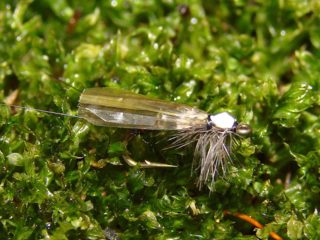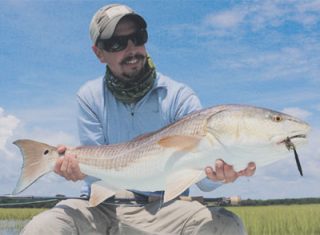
As we continue deeper into winter, much of the area is beginning to feel the icy grip of Jack Frost. Although most of the trout’s diet continues to be subsurface, during warmer periods there can still be some dry fly action to be had. The small winter stonefly becomes more active through the colder months and on warm winter days when the highs reach into the 30 to 40 degree range, these insects can become quite active. These winter stoneflies, like all other stoneflies, climb out of the water and hatch into adults.
Areas around bridges and rocky sections of a river are good places to start looking. They can become quite dense in areas and the trout begin to feed on them very heavily. They do not travel far from the water and during periods of heavy activity I will see them all over my equipment and hands. If there is snow or ice around during a hatch, they can be easily located as they will contrast with the snowy environment. They are black in color to help absorb heat from the sun, so areas where there is a significant and consistent amount of sunlight is where you’ll find them.
These little stoneflies are quite fun to watch scurry around, and to watch the trout feed on them can be quite beautiful. Since they don’t generally fly around a lot, they aren’t landing on the water and generating an ambitious rise from the trout. Instead, the trout will have a more delicate take like a sipping behavior.
All winter long, small black nymphs can be good prospecting patterns, as the stoneflies are always in the water. I like to use black Copper John nymphs in 16-20, black Pheasant Tail nymphs in 18-22 and black Hares Ear nymphs in 16-20 during the winter to imitate these little stonefly nymphs. Credit for this fly can be given to Brad Befus. I believe his original pattern was intended to be a Yellow Sally imitation. I have changed the tail, body and thorax to imitate better, the winter stonefly. This pattern has been in my box for over 10 years and has served me quite well through the colder winter months. Tie a few and keep them in the winter load out.
Best wishes and tight lines!
Hook: Tiemco 200R, #18-20
Thread: Giorgio Benecchi’s 12/0, Black
Tail: Black Micro Fibbets
Rib: Uni-Flexx in Black
Body: Black Superfine Dubbing
Wing: Medallion Wing Sheeting in Adult Stone (Tie in at hook eye, pulled over hackle, and tie off behind thorax.)
Thorax: Black Superfine Dubbing
Hackle: Dark Dun
Visual Indicator: Tulip Paint in your choice of color. I prefer white or orange. Without the puff paint, this fly can be very hard to see. The fly is designed to sit low in the water so using a puffy paint over a post works very well.
Dustin Stanberry is an instructor at Biltmore Fly Fishing and Sporting Clays located in Asheville, NC.
